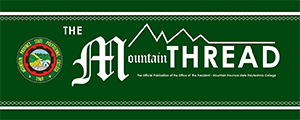IDENTIFICATION AND CHARACTERIZATION OF NATURAL DYE YIELDING PLANTS IN MOUNTAIN PROVINCE
George G. Lubin Jr. & Domingo L. Lawagey
ABSTRACT
The study was undertaken to identify and characterize the natural dye-yielding plants in Mountain Province. Specifically, the study aimed to: identify the existing natural dye-yielding plants in Mountain Province; characterize the different natural dye-yielding plants; and prepare a lexicon/journal of natural dye-yielding plants in Mountain Province.
Findings showed that the respondents mostly came from the municipality of Bontoc, followed closely by the group of respondents who came from the municipalities of Paracelis, Besao, Sadanga, and Tadian. The least of the respondents were from Sabangan, Mountain Province. Eastern Mountain Province used more of the claimed dye-yielding plants.
There were 76 natural dye-yielding plants identified by respondents in Mountain Province. Of the 76, 28 were further tried/tested and more than half or 48 were not tested. Also, 26 of the 76 claimed natural dye plants were truly dye-yielding plants.
Atteba (Viburnum polyanthum) was the most commonly indentified dye-yielding species among the 28 tested dyes of the respondents, followed closely by baat/farat (Musa spp.), dalangdang, adadasi, and anatel (Leukosyke capitellata). The most common source of dye among the tested dyes were the plants, fruit and bark/stem. The tried dyestuff were used in coloring cloth, hairs, paper, fiber, and face or skin, in painting paper, furniture and cloth art works, and in refilling ball pen ink. The plants identified to have dye properties are mostly trees that inhabit the forest. Eleven of the 28 tried species were truly dye plants. The eleven dye plants were Bua/Momma, Kunig, Ashuete, Camoras, Bugnay, Korar, Gumamela, Langka, Kayafiat, Malungay (Muringa Oliefera) and Sabawil (Mucuna puriens).
Of the untested claimed dye plants, 15 conform to the listed dye plants in the Philippines. The plants that conform to the listed dye plants in the Philippines are Lomboy (Syzigium cumini), Melina (Gmelina arborea), Narra (Pterocarpus spp.), Kaimito (Chrysophyllum cainito), Tuwor (Dillenia Phiippinensis), Niyog ( Cocos nucifera), Acacia (Samanea saman), Bugay (Basella lucida), Mayana (Colleus blumei), Alnus (Alnus spp.), Mahogany (Sweitenia spp.), Mahogany (Sweitenia spp.), Kamantiqui (Impatiens balsamina), Paparay (Ipomea batatas), Lantana (Lantana Camara), and Balete (ficus balete).
The source of dye (plant part) varies from plant to plant; however, majority of the dye source was the fruit juice. Far second was the leaf of the plant. More than half of the respondents said that the color of the plant extract was black to violet or violet to black .
The abundant dye species observed in Mountain Province are Mulberry, Avocado, Guava, Melina, Narra, Star Apple, Cherry, Alnus, Anatel, Lantana, Yellow bush, camote, Taogtog, Pising, Banana, Palumpong, Sunflower and Sagingsing.
The 76 identified dye plants are distributed to 33 trees, 18 shrubs, 4 palms, 10 vines, and 11 herbs. The taxonomically identified tree species belong to 15 families and 20 genera. The shrubs had 5 families each with one genus. The palm had 3 genera, and the vine had 3 families with one genus each and so with the herb. Taken as a whole, the 77 identified dye plants belong to 34 genera and 24 families.

















